1959 Portuguese Grand Prix race report: Moss trounces the field
Stirling Moss laps the entire field on his way to a supreme victory, closing the points gap to Jack Brabham; Coopers occupy three out of top four places
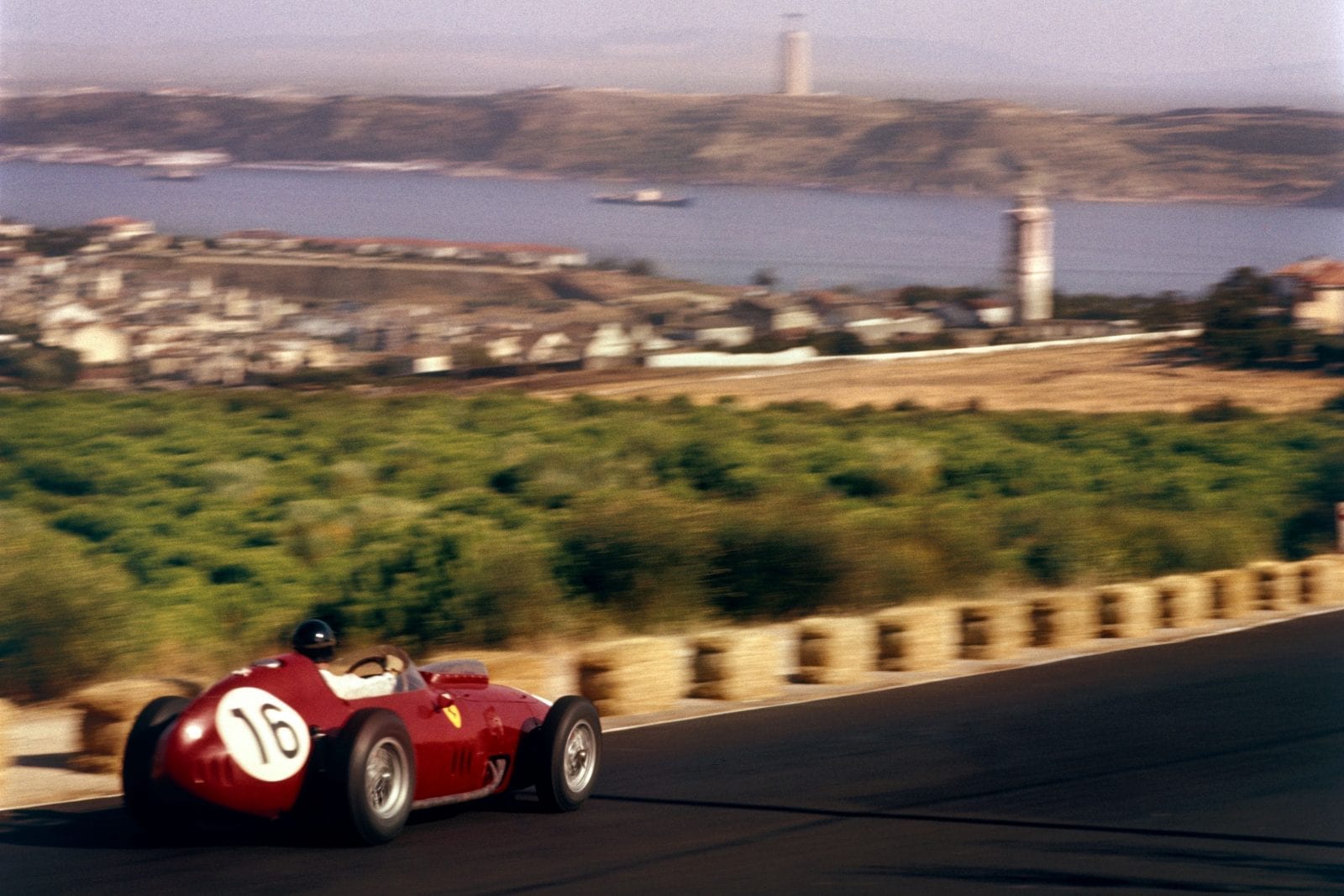
Dan Gurney in a Ferrari Dino 246
Motorsport Images
Having started Grand Prix racing in Portugal last year with the race at Porto, enthusiasm for such racing continued and this year the Portuguese Grand Prix was held at Lisbon, the National Automobile Club ringing the changes on the venue for their major motor-racing event in the same way as Great Britain does. For some years now sports-car racing has been held at Lisbon, on the Monsanto circuit just outside the town, and it was this circuit that was chosen for the Grand Prix.
Portugal is a peaceful and happy country and, possibly in consequence of this, they still encourage real road racing, unlike most other countries who have turned to artificial circuits. The Monsanto circuit has long been a favourite with sports-car drivers and past races have had some pretty select entries, many of them returning to the circuit more than once, for it is truly a ‘drivers’ circuit.
Of 5.44 kilometres in length, the start is on a slight uphill straight, but this almost immediately goes over a brow and starts a steep descent with a step in the middle, and at the foot of the hill the circuit takes a left turn with an adverse camber, crosses a main road, which is cobbled, and then takes a long right-hand hairpin which joins one side of a dual-carriageway. This is a big double-track motor road which leads into Lisbon and runs uphill and dead straight for nearly one kilometre, and then the circuit takes off to the right on an exit road from the main carriageway.
Running through a cutting and still climbing, the circuit crosses a minor road, levels out and starts a long sweeping right-hand curve that gradually “tightens-up” and ends in a sharp right-hand bend which is almost a hairpin. Running straight through some woods the circuit begins to descend, taking a fast right-hand bend, then climbs again through a sharp left-hand bend, runs level on a fast right-hand curve and then descends again to a slow left-hand corner at a cross-roads.
A little more level running and then a steep plunge is taken down a fast dropping-away left-hander, and then downhill to a double right-hand climbing curve that finishes on the starting line. The surface of the circuit is first-class tarmac, apart from the double-track road, which is concrete, and the short stretch of cobbles, but there are numerous bumps to make the suspension work and the whole nature of the circuit is one of pure road racing with nothing in the way of banked corners or wide open spaces to make things easy for the drivers; in fact, just the opposite, with tricky cambers, braking to be done on curves, blind corners, tree-lined sections and all the normal difficulties met with in everyday motoring.
The entry list saw all the regular Grand Prix teams entered and of the drivers, Moss, Gregory and Phil Hill had raced on the circuit before, the rest being newcomers to Monsanto. The weather in Portugal was superb, the sky being cloudless day after day, and though the sun was blazing hot, there was a cool breeze to even things up.
Qualifying
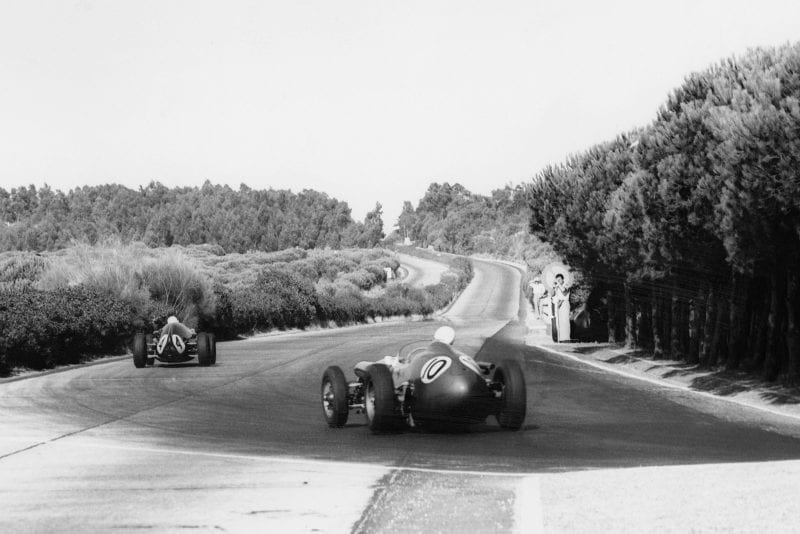
Roy Salvadori in his Aston Martin DBR4/250 chases Stirling Moss in his Cooper T51-Climax
Motorsport Images
Practice was on the Friday and Saturday preceding race day and took place at 6:15pm, leaving all day for preparation. On the first evening the only absentees were the two works Lotus cars, their transporter having broken down while crossing Spain, and while most of the entry were feeling their way round Moss went out and set a cracking pace. Not having had Grand Prix cars at Lisbon before there was no lap time set as a target, for the existing record was held by a sports car and that quickly went by the board.
Moss soon made it evident that his lap times were going to represent the target for the others, and he was lapping in under 2min 10sec even while he was playing around altering tyre pressures and fore and aft braking ratios; meanwhile nobody else was approaching this figure, most of them being around 2min 15sec. After a few adjustments the Cooper-Walker was proving admirably suited to the circuit and Moss went faster and faster, sliding the corners with a wonderful precision that looked to be care-free abandon.
“Moss soon made it evident that his lap times were going to represent the target for the others”
Trintignant in the second Cooper-Walker was thoroughly enjoying himself, the exacting road circuit suiting his immaculate and precise driving, while Gregory was at home, having won a race on this circuit in 1955, and he was faster than Brabham, who was adapting himself and his car to the conditions. The third works Cooper, driven by McLaren, was going pretty slowly, having been fitted with an axle ratio that was hopelessly low and he was also delayed by an air-lock in the water system that took some time to disperse.
The Ferrari team of Brooks, Phil Hill and Dan Gurney were far from happy for they thought before practice started that their cars would be ideal for the circuit, especially on the long climb up the dual-carriageway, but in practice they were disappointed and they found they could not approach the times set up by Moss, none of them getting near to 2min 10sec. Whereas the Coopers could be flicked from lock-to-lock, provoking over or understeer at will, the Ferraris seemed rather jumpy and did not encourage the driver to let them get out of line.
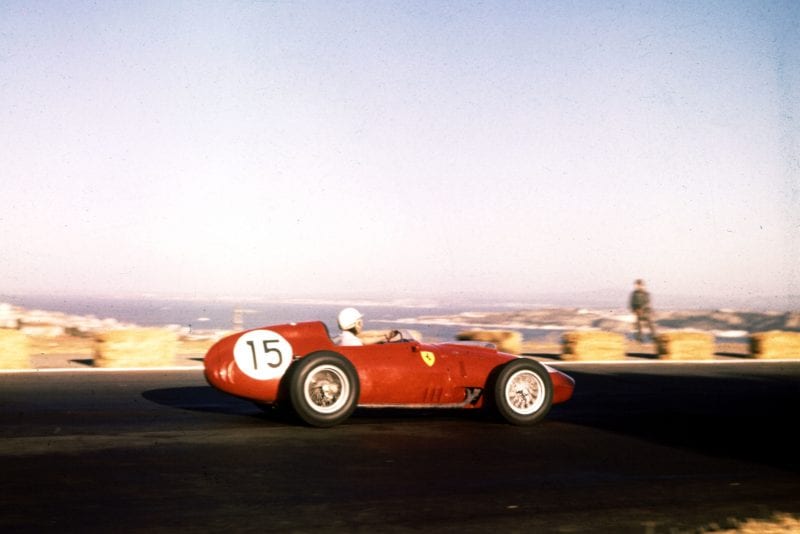
Phil Hill in his Ferrari Dino 246
Motorsport Images
The two works Aston Martins, driven by Salvadori and Shelby, were making only their second appearance outside of England and while being delightfully easy and steady to drive they did not have the power to challenge the others. BRM were running three cars, driven by Schell, Bonnier and Flockhart, and of the three Bonnier was on great form and got down to 2min 10.8sec. To complete the field the Scuderia Centro-Stud entered one of their Cooper-Maseratis, which was driven by a local boy named Araujo Cabral who was feeling his way along gently, never having been in a single-seater before.
By the time practice had finished Moss had got the Cooper adjusted to his liking and had lapped in 2min 05.69sec, which was way ahead of anyone else; the timing was highly organised and was being done to a hundredth of a second. Only two other drivers got below the bogey time of 2min 10sec, these being Gregory with 2min 08.61sec and Brabham with 2min 09.21sec, the rest being two or three seconds slower.
On Saturday evening practice recommenced and straightaway Moss was going as fast as ever and soon improved on his times of the day before, but now Brabham was in his stride and was well below 2min 10sec, as was Gregory, and McLaren got down to 2min 08.17sec, having had the right gear ratios fitted. Everyone was going faster now that they had got their cars adjusted to the circuit and had learnt the way round, all that is except Graham Hill and Ireland in the works Lotus cars for they were out doing their 12 qualifying laps.
Hill was in trouble with a brake master cylinder which lost him a lot of valuable practice time, and Ireland was bothered by a faulty gear-selector mechanism, so that all he could do was to tour round and qualify. The Ferrari team were still not content, their cars giving them a bumpy ride, and though they had a spare car with them it was worse than the three team cars and Brooks was right off form and could not even break 2min 10 sec.
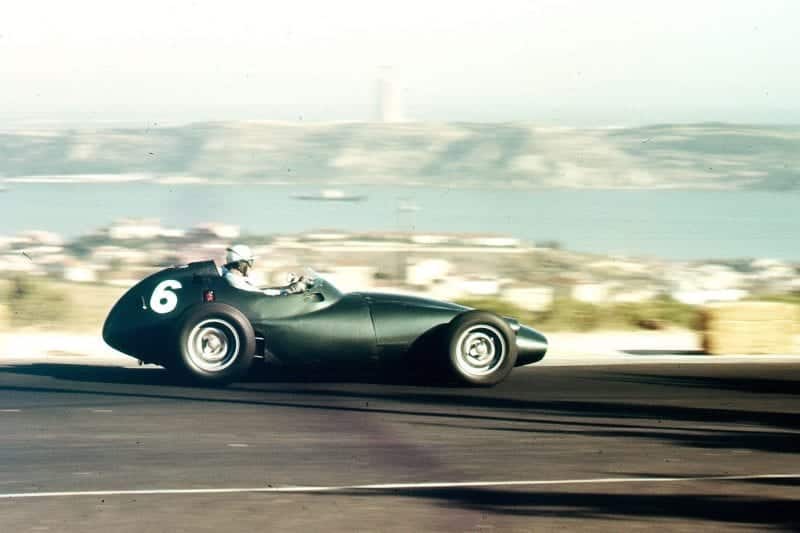
Harry Schell in his BRM P25.
Motorsport Images
The new-boy Gurney was just pressing on with what he’d got and was the fastest of the team, with a time of 2min 07.99sec, which was almost as quick as Bonnier in the very steady-looking BRM and Trintignant in Walker’s second Cooper, who was in splendid form. Schell was obviously trying as hard as he could, but only just got below 2min 10sec, and Flockhart was driving well and almost keeping up with his team-mate.
Towards the end of practice Brabham was going very fast and working hard, getting down to 2min 04.95sec, but Moss had already set FTD at 2min 02.89sec, the circuit allowing drivers to really shine. Both Moss and Brabham were using Climax engines with new cylinder heads, as at AVUS, the redesigning of the ports and combustion chamber giving some 12-15 bhp more over the normal 2½-litre Climax.
As Moss also had a five-speed gearbox against Brabham’s four-speed, which must have helped considerably on this fast winding circuit, much of the credit for these two being well out in front should be accredited to cars; even so they still had to be driven and Moss and Brabham were really driving them. Ferraris were quite delighted with Gurney’s times, Phil Hill had reconciled himself to second place and Brooks was thoroughly discontented both with his own car and the spare one, nothing seeming to be quite right for his tastes. Just as practice was over Shelby hit some straw bales in his Aston Martin, folding up the nose cowling, and Bonnier went off the road in the BRM but there were no serious consequences.
Race
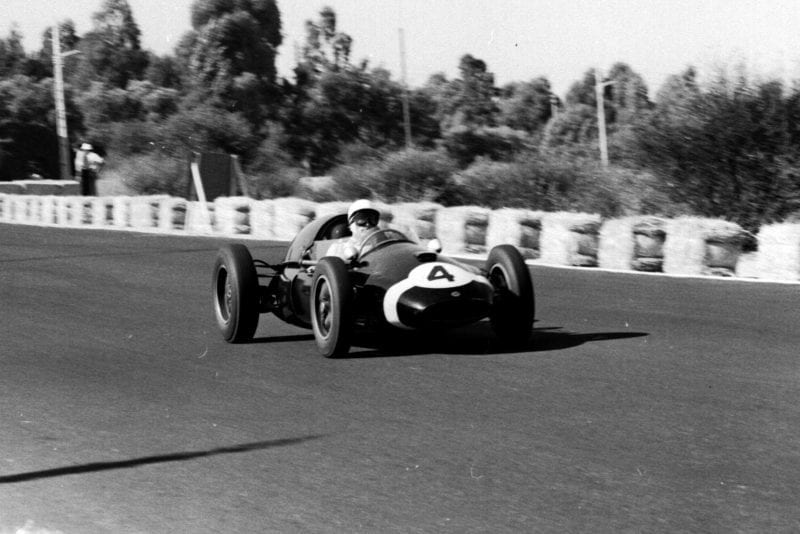
Stirling Moss in his Cooper T51 Climax.
Motorsport Images
Sunday was another glorious sunny day with a gentle cooling breeze, and in view of the anticipated heat the race was arranged to start at 5pm over 62 laps of the 5.44-kilometre circuit. The cars were lined up in rows of three, two, three, with Moss in No. 1 position with his time of 2min 02.89sec, a speed of 159.362kph (approximately 99mph), the rest of the sixteen starters being in order of practice times.
With the start being on a slight uphill slope, Brabham’s mechanic put a small stone behind the back wheel to check the car, and as the flag was raised McLaren began to creep forward from the third row. Down went the flag and it was Brabham away first, his rear wheel shooting the small stone like a bullet into the cars behind. Gregory was up with him but Moss was lagging a little, and as they all roared off over the brow of the hill, Bonnier’s BRM cut-out and he was passed on all sides, and Brooks had to brake heavily to avoid ramming the tail of the BRM. Before they were half-way round the first lap Moss had taken the lead from Brabham and McLaren had passed Gregory.
“Down went the flag and it was Brabham away first, his rear wheel shooting the small stone like a bullet into the cars behind”
Moss appeared round the double curve preceding the pits with his tyres whistling and already had a substantial lead over Brabham, McLaren and Gregory, while Gurney, Phil Hill and Trintignant were nose to tail, followed at a distance by Schell and then Shelby, Graham Hill, Salvadori and Flockhart close together, with Brooks behind them having made up no ground after being baulked at the start, and he was only just leading Ireland and Cabral. Right at the back came Bonnier, his engine having picked up but not running correctly. On the next lap Phil Hill went wide at the foot of the descent and then took to an escape road, and as a result dropped right back, leaving Gurney and Trintignant to close up on Gregory.
With Coopers in the first four places and drawing away all the time the race result was almost foregone for Cooper reliability is of a pretty high standard. By lap four Moss had an 8sec lead over Brabham and already Ireland had been into the pits to cure a misfiring plug and had then retired with gear-selector trouble. Moss was pulling out a lead of a steady 2 to 2½ seconds a lap, and Gregory was closing on McLaren and getting away from Gurney and Trintignant, who were still nose to tail.
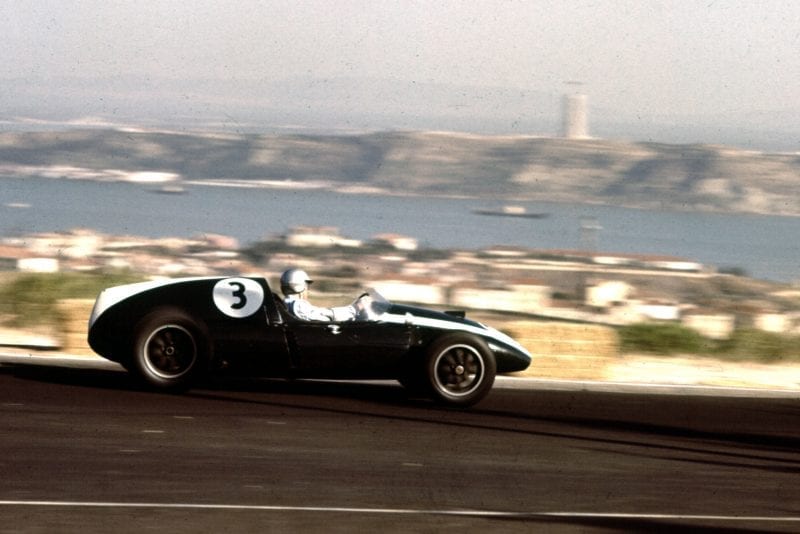
Bruce McLaren driving his Cooper T51 Climax.
Motorsport Images
Behind them Schell was a lonely seventh and Graham Hill had shaken off the two Aston Martins and Flockhart, while Phil Hill and Brooks were beginning to move up. On lap six Hill G was going up the dual-carriageway followed by Hill P and as the Lotus went into the cutting it spun, mounted the bank, came back in the road and was broadside on as the Ferrari arrived braking hard. Being unable to stop in time Phil Hill hit Graham Hill, and as the cars bounced apart Flockhart went through the gap! The Lotus came to rest somewhat bent and the Ferrari was smashed in at the front and had its wheels splayed out. Conscious of being in a dangerous position Hill drove the bent Ferrari up the road and parked it in a side turning.
Bonnier was still bringing up the rear, not yet having caught Cabral, and was still troubled by misfiring, coming into the pits on lap nine to have the Weber carburetters looked at although nothing could be found wrong he only did one more lap, still misfiring badly, and then the engine died altogether with fuel-feed trouble. Meanwhile, Moss had increased his lead to 17sec and was now touring round in 2min 10sec, having plenty in hand, while the works Coopers were following, now in team order, Brabham, Gregory, McLaren.
Behind the four Coopers Gurney was the only Ferrari hope and he was having a wonderful scrap with Trintignant, but after that there was a long pause before the “also-rans” arrived, Brooks still among them, while with Bonnier retired Cabral was now bringing up the rear and not going too badly in his first Grand Prix.
Apart from the Gurney/Trintignant battle the race now developed into a bit of a procession, with Moss literally out-driving everyone. He lapped Cabral, then Shelby and then Brooks, who came by the pits looking unhappily at his back wheels, then Brabham still in second place, lapped Shelby, and the Aston Martin driver looked over his shoulder expecting to see a horde of Coopers on his tail. Schell was finding his brakes pulling up inconsistently and Flockhart was pressing him hard, to take seventh place from him on lap 16 and driving well in spite of a gear-change that was not functioning properly, and Brooks was making no headway at all at the back of the field. The Ferrari pit signalled him a lap time of 2min 18 sec and he looked back as if to say, ‘So what!’

Roy Salvadori in his Aston Martin DBR4/250.
Motorsport Images
Not far in front of him was Shelby taking things easy in the Aston Martin, realising there was no point in dicing for he had no hope of catching anyone and Brooks showed no inclination to press him. On lap 22 the Ferrari pit signalled to Brooks to say, “Well, if you can’t win, for goodness’ sake try and catch Shelby,” to which Brooks replied by coming into the pits on the next lap to complain that the thing just wouldn’t get maximum revs, and after looking vaguely at the engine the mechanics sent him off again, now in last place. Up front Moss was steadily lapping everyone without even trying to go fast and had now lapped the two BRMs and only the first six cars were on the same lap. The hard work of the circuit, together with the heat, was beginning to tell and Trintignant slowed a little, which gave Gurney his chance to get away.
On lap 24 Moss was on the return run down the winding leg of the course while Brabham was leaving the dual-carriageway, followed by Gregory and McLaren. As the Australian went into the long curving right-hand bend towards the sharp right-hander at the far end of the circuit he was about to lap Cabral in the Cooper-Maserati but timed things just wrong so that he got too far out on the left, deep into the braking point, and hit the straw bales, sending the Cooper over into a telegraph pole, wrecking the car badly and flinging himself out into the road, to be narrowly missed by Gregory who was following. Brabham was very lucky to get away unhurt, and next time round Moss practically stopped at the Cooper pit to say Brabham was all right.
“Brabham timed things just wrong so that he got too far out on the left, deep into the braking point, and hit the straw bales, wrecking the car badly and flinging himself out into the road, to be narrowly missed by Gregory who was following”
Moss was so far in front of everyone now, lapping at 2min 12sec, that he was hardly bothering to change gear for some of the corners, pulling leisurely away from 4,000rpm. Gregory was showing signs of thirst and Trintignant was looking very hot and tired, while Gurney was now well away, in fourth place and gaining on McLaren, lapping most consistently just under 2min 08sec, and Phil Hill signalled him this information from the pits and encouraged him to keep up the good work.
At half-distance, or 31 laps, Moss had just on 60sec lead over Gregory and the race had become a Moss demonstration run. Trintignant went past the pits on lap 33 indicating he wanted water poured on him, and the next lap slowed right down to make sure his mechanics understood his signal. On the next lap he stopped and had a can of water poured down his back and then went on, still holding fifth place but now having been lapped by Moss.
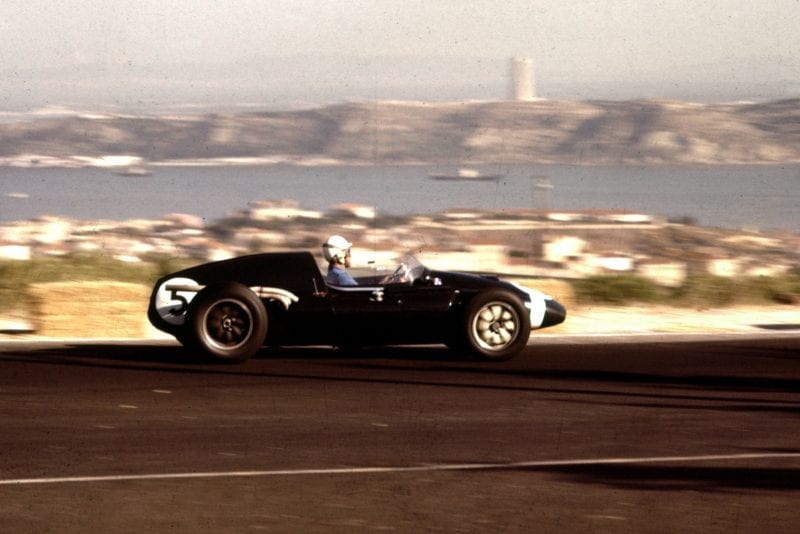
Maurice Trintignant at the wheel of his Cooper T51 Climax.
Motorsport Images
On lap 36 Flockhart came in for fuel as a precaution, having done a lot of motoring in third gear due to his gear-change being at fault, and also to have a slight breather, but this stop allowed Schell to go by him back into sixth place. On lap 39 McLaren stopped at his pit with a grinding noise coming from the transfer gears between the clutch and gearbox, and that was that, so the order was now Moss, Gregory, Gurney, on the same lap, followed by Trintignant, Schell, Salvadori, Flockhart, Shelby, and a long, long way behind came Brooks, who had at last managed to catch Cabral; after his pit stop Flockhart had lost another place by indulging in a spin.
At 40 laps there was no sign of any motor racing going on for everyone had acknowledged the mastery of Moss and settled down to touring in to finish. As the leader went by on lap 45 he leant out of the cockpit and held his nose, looking to the rear, and though it was not obvious what was smelling he did not seem perturbed; in actual fact he could smell petrol from a slight leak in one of the tanks.
Salvadori had been driving a regular and steady race and was now sucking a damp towel to try and combat the heat, and on lap 47 Moss lapped the third man, Gurney. Without trying, he was closing on Gregory to lap him, and he ticked the laps off with complete regularity and looking so much at his ease. Trintignant was now two laps behind Moss and nearly one behind Gurney, so he was taking things very easily and as he came down the hill towards the pits bend Gurney came up to lap him. Seeing this in his mirror the Frenchman lifted right off but this caught Gurney by surprise, not being used to such gentlemanly behaviour, and having aimed his Ferrari to pass the Cooper going into the bend he suddenly found himself running up its rear and the nose of the Ferrari rode up a rear wheel on the Cooper. The radiator cowling was completely squashed in, but with only six laps to go Gurney eased off and drove gently, keeping an eye on the water temperature, which was rising rapidly. On lap 58 Moss lapped the second man, Gregory, and that was that, he had dominated the entire field without straining himself or the car.
To a terrific ovation from the crowds Moss finished his 62nd lap, to win his first Grande Epreuve of this season, but to win it so thoroughly that it made up for all his past failures. The rest of the runners were flagged off and some very tired and hot drivers got out of their cars, for it had been a hard and long drive.
Portuguese Ponderings

Stirling Moss celebrates with after winning.
Motorsport Images
- Almost everyone appreciated practice being in the early evening, for it allowed all day to relax or work, depending on whether you were a driver or a mechanic.
- Full marks to the friendly and helpful Automobile Club of Portugal, and for the Press arrangements whereby a chair and desk space were allocated with a named ticket to each journal, instead of the usual miserable business of fighting and arguing for a seat.
- The timekeeping arrangements were a huge improvement on the ‘sand-timers’ used at Zandvoort or the ‘egg-timers’ used in England. Watches reading to 1/100 of a second were used and official results gave each driver’s fastest lap and when he recorded it. Moss was almost two seconds faster than the next fastest, who was Brabham, and he made it on his 28th lap whereas Brabham did his on his 11th lap.
- The Aston Martins were never in the picture, but it was not so long ago when Vanwall were in a similar position, yet last year they swept the board, and not many years ago Cooper were not even in Grand Prix racing. We hope Feltham will not despair, for the cars are beautifully made and are a credit to any starting grid.
